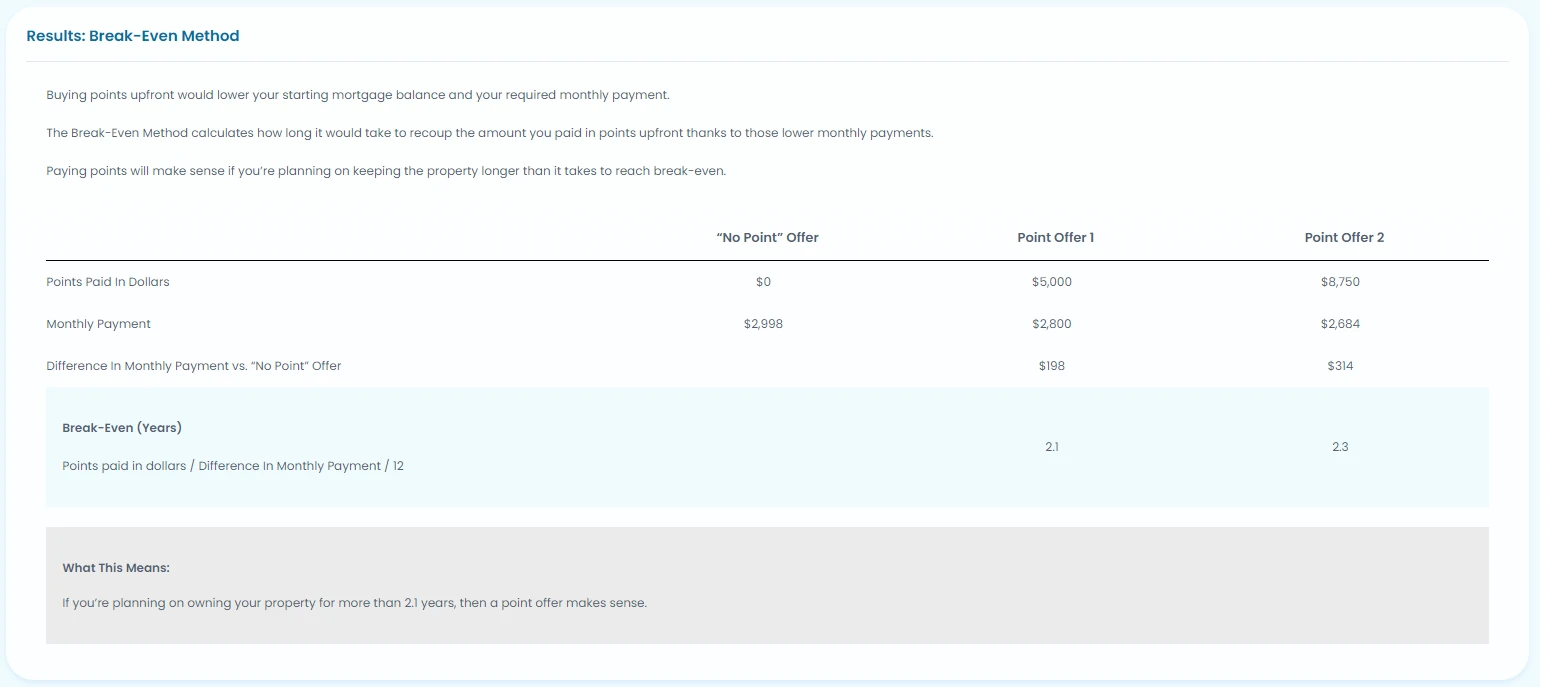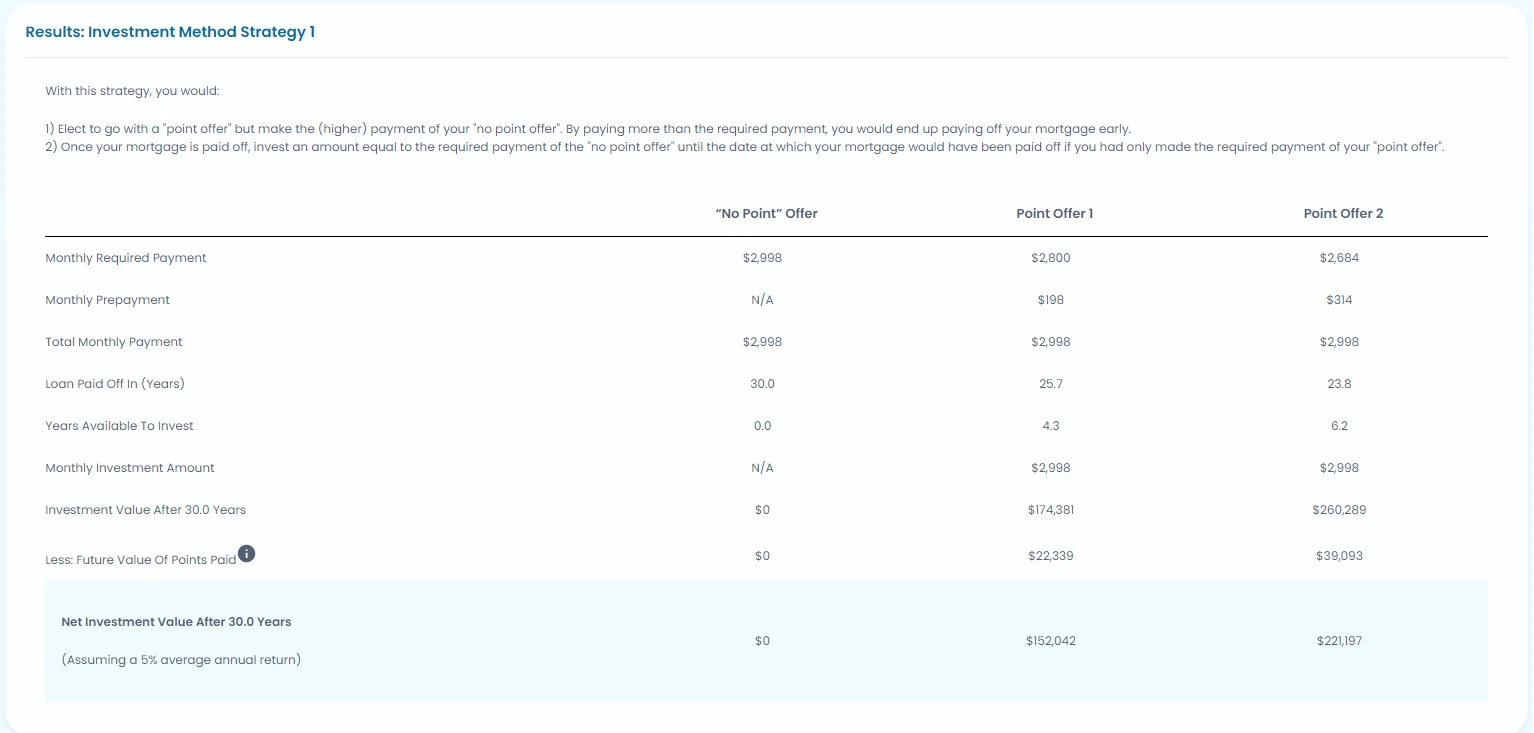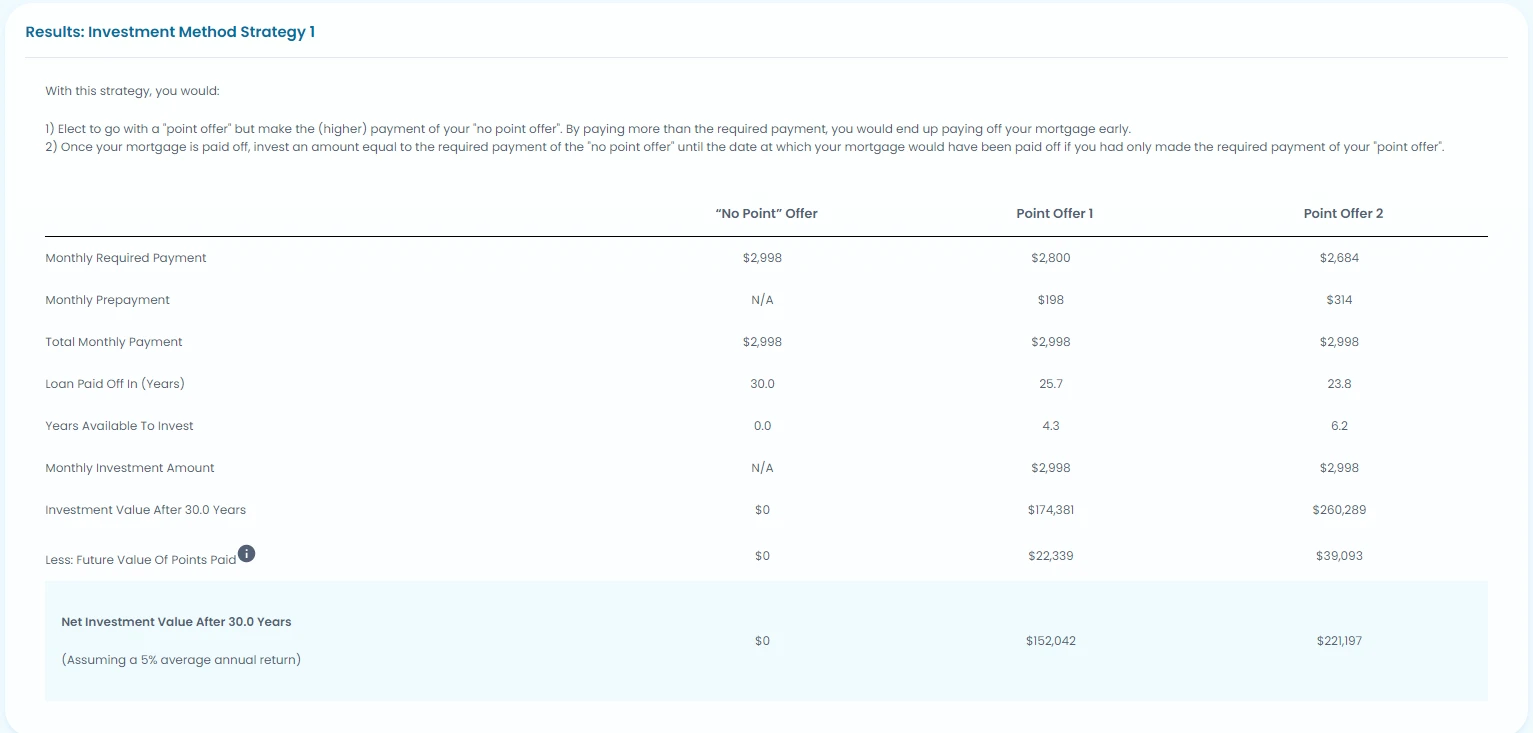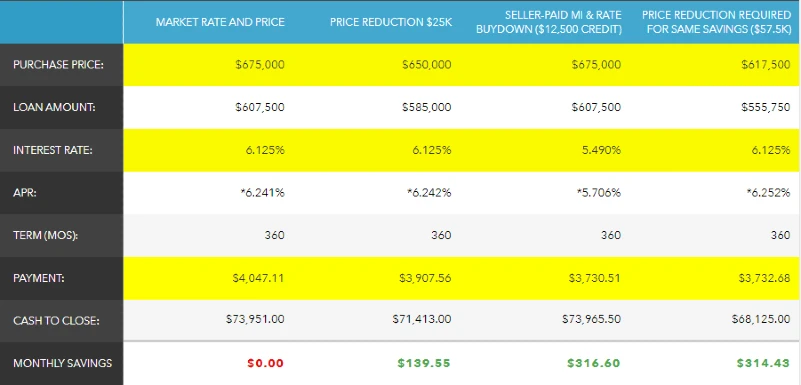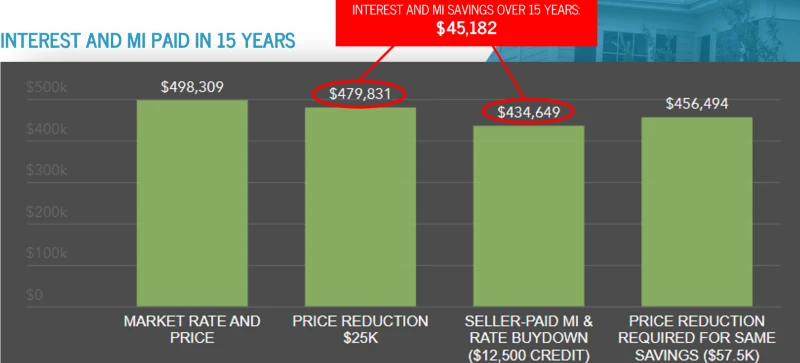Home prices are at all time highs. Mortgage rates are climbing. To make things even more challenging, many young professionals are trying to buy a house with student loan debt.
Buying mortgage points may be your secret weapon to reducing the cost of your mortgage and saving a ton of money.
Below, I detail:
- How mortgage points can save you $1,000s;
- When you buy points…and when not ; and
- Multiple ways to determine whether paying mortgage points is right for you.
What Are Mortgage Points?
The Federal government defines points as a way to “lower your interest rate in exchange for an upfront fee.” Mortgage points are also referred to as ‘buying down the rate’ or ‘discount points.’
One point is equal to one percent of the starting loan balance. For example, buying one point on a $400,000 mortgage would cost you $4,000.
Finance people like to confuse you so mortgage points are are often referred to as “basis points”.
This terminology is important to know because lenders often times use it. For example, instead of saying the cost to lower your mortgage rate is .25 points, they will say that it costs 25 basis points. This means the cost is 0.25% of the mortgage. I.e. on a $400,000 mortgage, the cost would be $1,000.
How much each mortgage point lowers the rate varies on a number of factors. The factors are:
- The lender: All lenders have different amounts each point lowers the interest rate
- The type of mortgage loan
- The interest rate environment, i.e. are rates going up, down, flat, etc…
Points will be listed on your loan estimate document and the closing disclosure. You then pay them upfront, at the closing of the loan, and they are considered prepaid interest.
Being considered prepaid interest is important for tax deductibility which I touch on more in a later section.
Is It Better To Pay Mortgage Points Or Have A Higher Interest Rate?
Short answer, it depends. I will discuss a few scenarios below to help answer the question. However, there is one item I want to point out first.
Paying mortgage points is often discussed because it can save you thousands on a mortgage. However, if you use them incorrectly it can actually cost you thousands!
People often make the wrong choice because they use what is called the Cost Method. This method unfortunately is the wrong method to determine whether one should buy points.
The Cost Method strictly looks at the cost of a mortgage over the life of the loan when you buy points and when you don’t. The problem is that this method doesn’t factor in time.
I will discuss two methods you should use in a minute. But first, I will provide a high-level framework.
Generally, the longer you will stay in the home and pay off your your mortgage, the more it makes sense to buy points. Since buying points up front reduces your monthly mortgage payment, the longer you stay in your home, the more you save relative to paying no points. Therefore, the longer you are in your home, the more you save.
Next, I describe how people costs themselves greatly by making two major mistakes.
Mistake 1
People who bought points often shy away from refinancing, even if they can get a better rate. In their mind, since they bought points, they want to keep “benefiting from their purchase.” In other words, they are looking in the rear-view mirror.
This is absolutely the wrong way to look at refinancing. The points you paid in the past should be considered a sunk cost. You paid them already and you can’t change that.
The real question you have to answer is “Does refinancing (with or without paying mortgage points) put me in a better position today relative to my current mortgage?”
Mistake 2
I’ve been seeing this advice a lot lately and it makes me cringe every single time. It goes something like this?
“Don’t pay mortgage points right now because rates have risen. Wait until rates come back down and refinance at that time instead. There is not point (pun intended) to pay mortgage points for no reason since you’re going to refinance anyway.”
Horrible, horrible, horrible!
Nobody knows what the future holds for interest rates. If they do go down, nobody can tell you when they are going down. If they do.
Therefore, you have to make your decision based on what you know today. When/if rates do go down, do the analysis discussed next to determine whether you should refinance and pay mortgage points again.
Two Methods Used To Determine If You Should Pay Mortgage Points
There are two methods you should use when it comes to mortgage points. They both answer:
- Whether should pay mortgage points, and, if so:
- How much you should pay.
The two methods are:
- The Break-Even Method
- The Investment Method
The break-even method is most commonly used because it’s the easiest to calculate. However, I recommend using the investment method. I explain both methods below and detail why I favor the latter.
The Break-Even Method
When you pay mortgage points on a mortgage you are reducing the interest rate. Therefore, you reduce your required monthly payment.
The difference between the monthly payment amounts is your ‘savings.’
For example, a no point loan has a monthly payment of $1,000. A loan paying one mortgage point has a monthly payment of $950. Your monthly savings is $50.
Then you simply divide the cost of the loan by the monthly savings. The result is how many months it would take for you to ‘break-even.’
Before diving into an example, let me highlight a critical item first.
Critical Item You Need To Know
As I previously mentioned, you have to decide how long you are going to keep this specific mortgage. Notice I said “mortgage”, not “home.”
Many people make the mistake of comparing the break-even point to how long they will be in the house. Using both terms interchangeably only make sense if you are planning on selling the house say within five years because you would get rid of both at the same time considering the short amount of time you would keep the house.
Now, here is the key statistic you need to know. The majority of mortgages (not necessarily the ownership of a given home) are ended within 10 years.
People often times refinance and get a new mortgage to save money. Sometimes they need money for something else like a medical emergency and do a “cash out” refinance. Other times people may pay off the loan in 10 – 15 years because they just don’t like debt etc.
With this number in mind, the rule of thumb is that you typically want to break-even within 6 years. Obviously, the sooner you break-even, the better.
Here is an example:
Example Of The Break-Even Method
Let’s say you have three offers for your $400,000 mortgage:
- Pay no mortgage points and get a 6% rate
- Pay one mortgage point (i.e 1%or $4,000) and get a 5.625% rate
- Pay two mortgage points (i.e. 2% or $8,000) and get a 5.375% rate
Below is the results from FitBUX’s mortgage point calculator. As you can see, your break-even for paying one mortgage point is 3.5 years and is the better offer. Therefore, if you foresee staying in your home (or holding that mortgage) for more than 3.5 years you would pay the mortgage point.
The Investment Method
I mentioned earlier that the investment method is the best method to use. The reasons are:
- It will show you the true value of paying mortgage points over time
- It will help you maximize your financial plan
As we’ve discussed, paying mortgage points reduces your monthly payments. From there, you have three ways to deploy the money you’ve saved each month. You can:
- Spend it
- Use it to prepay the mortgage and pay off your mortgage early
- Invest it
If you are going to spend it, then the break-even method will work for you. Simple.
However, if you’re considering investing or paying off debt, the investment method is the way to go.
The investment method calculations are complex. This is why FitBUX has built a calculator (available in our free membership) which does the heavy lifting for you.
If you like details, dive deeper in this mortgage point calculator article.
Example of the Investment Method #1
I will illustrate the investment method using the same figures I used in the break-even method.
Option 1: Pay one mortgage point and use the savings to prepay the mortgage.
If you did this, your estimated net investment value in 30 years would be $70k.
Now, let’s look at it from an investment standpoint:
“I make a $4,000 investment today, it will grow to approximately $70,000 over the next 30 years. Is that worth it to me based on my own situation?”
If the answer is yes, pay the mortgage point.
Example of the Investment Method #2
Option 2: Use your savings and invest it immediately instead of paying off the mortgage early.
If you did this, your estimated net investment value in 30 years would grow to $61.5k.
Do you believe a $4,000 investment is worth $61.5k over 30 years? If yes, then pay one mortgage point.
The Investment Method Is The Way To Maximizing Your Financial Plan
The great thing about the Investment Method is that it’s a key calculation when you build your financial plan
If you use option 1 and use the savings to pay off your mortgage early, your net investment value will grow to $70k.
If you use option 2 and invest the savings instead, your net investment value will grow to $61.5k.
Therefore, to maximize your finances, you’d want to use option 1 as your investment will grow more over 30 years. Use the savings to pay off the mortgage faster since the net investment value is more than option 2.
Seller-Paid Points Interest Rate Buy Down Strategy
Yes, it’s a mouth full. It basically means that the *seller* will pay for points to help get a deal done.
A seller’s market is where sellers set the terms due to lack of housing supply. Conversely, a buyer’s market is when buyers set the terms due to an oversupply of housing.
Currently, many real estate markets across the country are shifting from a severe seller’s market to a balanced/buyer’s market. This means sellers are seeing less potential buyers, and homes are also staying on the market longer.
Therefore, sellers get motivated to offer concessions such as price reductions or seller-paid closing costs.
When contemplating a transaction, buyers want to focus on reducing their monthly payments and make the home as affordable as possible. Therefore, in a buyer’s market, many will put in an offer at a reduced price.
However, sellers may still be reluctant to drop the price. If the seller is stuck ona given price, buyers should consider asking the seller to contribute towards the buy-down of their mortgage rate as opposed to reducing the sales price. In effect, the seller is buying points on behalf of the seller.
In fact, a seller contribution can be two to three hundred percent more effective to reduce the monthly payment than a direct price reduction. Let’s look at an example.
Example Of Seller-Paid Points
Here’s an example of how powerful this seller concession can be. In the example, we used seller-paid points to buyout mortgage insurance and reduce the interest rate.
The first column below is the Market Rate And Price. You will see a market rate for an average credit score borrower and the monthly payment. The monthly payment includes principal, interest, taxes, insurance, and mortgage insurance.
The second column assumes the borrower negotiates a $25k price reduction. Therefore, the monthly payment is reduced by $139.55.
The third column assumes the buyer does not want to negotiate a price reduction. Instead the buyer was able to negotiate a seller concession of $12.5k. The seller concession was then used to first buyout the mortgage insurance for $4.3k. Then the seller concession was used to permanently buy down the interest rate with the additional $8.2k.
This strategy resulted in an interest rate reduction of .626%, the elimination of the monthly mortgage insurance premium, and a monthly payment savings of $316.60.
The fourth column compares the monthly savings of a price reduction relative to using the seller concession to pay points. In order to get the same savings, the seller would have to agree to a sales price reduction of $57.5k!
Obviously as a buyer, you want to negotiate as much of a sales price reduction and seller concessions as possible. However, many markets are still decently competitive. Therefore, it’s much more likely you will be able to negotiate a $12.5K seller concession than a $57.5k price reduction.
The Long-Term Benefits Of Seller Paid Points
This strategy is powerful for maximizing monthly affordability. It also compounds for massive long-term savings. Over 15 years, the seller paid mortgage insurance and rate buydown strategy saves $45,182 more than a $25k price reduction strategy.
In summary, negotiating seller paid concessions to permanently buydown the rate of your mortgage and buying out the mortgage insurance are strategies that maximize homebuyer affordability. They are much more effective at reducing the mortgage costs than are purchase price reductions alone.
Mortgage Point Tax Deductibility
Good news. Mortgage points are prepaid interest. Therefore, they are tax deductible.
If you have a property purchased prior to December 2017, you can deduct the points if your mortgage was less than $750,000. If you bought a house after December 2017, you can deduct them if the mortgage was less than $1,000,000.
You do not get to deduct all the points in the same tax year however. Each year, you can deduct only the amount of interest that applies as mortgage interest for that year.
However, there is one primary exception when you refinance your mortgage or sell your house. In this situation, the amount of mortgage points you haven’t deducted can all be deducted in the tax year the house was sold.
For example, let’s say you paid $3,000 in mortgage points. After x years you have already deducted $1,000 and sell your house. Then you can deduct $2,000 in that tax year.
Frequently Asked Questions
[sc_fs_multi_faq headline-0=”h3″ question-0=”How many mortgage points can I buy?” answer-0=”Technically, you can buy as many as you want. However, the more you buy the more they cost and the less the interest rate drops. For example, one point might drop the rate by .25%. 2points might only drop it another .15%. Therefore, the longer your break-even point becomes.” image-0=”” headline-1=”h3″ question-1=”Why do lenders offer points?” answer-1=”Money today is more valuable than money tomorrow. Therefore, lenders do a calculation whereby they are indifferent as to receiving the interest up front or over time. That is how they calculate the cost and interest rate decrease when buying points.” image-1=”” headline-2=”h3″ question-2=”How do mortgage points work with ARM Loans?” answer-2=”Mortgage points on an adjustable rate mortgage (ARM) work exactly the same as fixed rate mortgages. However, most ARMs adjust in five or seven years. This is important because ARMs are most of the time refinanced. If they aren’t refinanced, then the points aren’t applied once the loan starts adjusting. The lower interest rate only applies to the fixed rate time period. The fixed interest rate period is typically five to seven years. Therefore, it is really important to calculate the break-even points. However, most of the time it makes no since to pay points on an ARM.” image-2=”” headline-3=”h3″ question-3=”Can you negotiate points on a mortgage?” answer-3=”You can negotiate origination points but these are different that points to reduce the interest rate. When it comes to negotiating paying points to reduce the interest rate, the answer is no!” image-3=”” count=”4″ html=”true” css_class=””]
Calculators & Other Resources
FitBUX has rolled out the first ever home ownership suite of technology and services. As part of that suite, we have rolled out four technologies to make your home buying experience better. You can read more about by click on the relevant link below:
- Mortgage Point Calculator
- Mortgage Payoff Calculator
- How Much Home Can You Afford
- Should I Rent Or Buy A Home
- 5 Items to Know When Buying A House With Student Loans
By Joseph Reinke, CFA and Josh Mettle, Neo Home Loans
